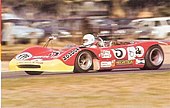- Race start in Buenos Aires.
- Numa-Tornado, first championship winning car.
- Huayra Pronello-Ford.
- Chelco-Chevrolet driven by Néstor García-Veiga, 1972.
- Luis Rubén Di Palma and Berta-Tornado, winners of the last three championships.
Related Research Articles
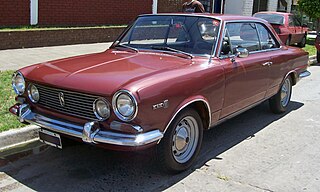
The IKA Torino, later Renault Torino, is a mid-sized automobile made by Industrias Kaiser Argentina (IKA) under an agreement with American Motors Corporation (AMC) in 1966. The 1966 Torino was IKA's first national product. IKA was eventually bought out by Renault in 1975 to form Renault Argentina S.A.
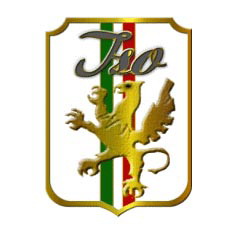
ISO Rivolta is an Italian car and motorbike manufacturer active in the motor vehicle sector since 1938. Over the years, the company has taken various names, including Isothermos, Iso Autoveicoli Spa in 1952, Iso Rivolta in 1962, Iso Motors in 1973 and, in 2017, a return to ISO Rivolta.

Turismo Carretera is a popular stock car racing series in Argentina, and the oldest auto racing series still active in the world. The series is organized by Asociación Corredores de Turismo Carretera.

The Alfa Romeo 33 Stradale is a mid-engined sports car built by Italian car manufacturer Alfa Romeo. It is one of the world's first supercars; it was the fastest commercially available car for the standing kilometer when introduced. 18 examples were produced between 1967 and 1969. "Stradale" is a term often used by Italian car manufacturers to indicate a street-legal version of a racing car; indeed the 33 Stradale was derived from the Tipo 33 sports prototype.

Rubén Luis di Palma was an Argentine racing driver. He won the Sport Prototipo Argentino championship in 1971, 1972 and 1972, the Turismo Carretera championship 1970 and 1971, the Fórmula 1 Mecánica Argentina championship in 1974 and 1978 and the TC2000 championship in 1983. He died in September 2000, when the Robinson R44 helicopter he was flying spun out of control and crashed near Carlos Tejedor, Buenos Aires Province.
Eduardo José Copello was an Argentine racing driver. He won the Turismo Carretera championship in 1967 and the Sport Prototipo Argentino championship in 1969.

The Chevrolet 400 was a compact car made by General Motors de Argentina from 1962 to 1974. The "400" was General Motors's reply to Ford and Chrysler after those companies introduced the first compact cars to Argentina, the Ford Falcon and Valiant II respectively.

Industrias Aeronáuticas y Mecánicas del Estado was a state-owned entity and autarchic conglomerate of factories of Argentina created in 1951 to promote the manufacture of aircraft and automobiles during the Juan Perón administration.

The SEAT Altea Prototipo is a 2+2 seater concept car presented by SEAT for the first time at the 2003 Frankfurt Motor Show, the first SEAT model to be produced inside the Audi brand group, which was unveiled with the aim to give a preview of the SEAT Altea's definitive road version, which was meant to be launched a year later in 2004.

Huayra Pronello Ford is an Argentine racing car built in 1969. It was designed by Heriberto Pronello for the official Ford Sports-Prototype team. The Huayra was powered by a five-liter Ford V8 producing 430 hp, with four Weber 48/48 IDF carburetors. Driven by Carlos Pascualini and future competitive Formula One driver Carlos Reutemann, it was the fastest car in both qualifying and race in nearly all of Argentina's Turismo Carretera races in 1969.
Tulio Crespi S.A. is an Argentine automobile manufacturer, founded in 1962 by Tulio Crespi, a former racing driver. With an industrial plant in Balcarce, Buenos Aires, Crespi has been producing automobiles and Formula racing vehicles.
Industria Argentina de Vehículos de Avanzada was an automotive company created in 1971 by 16 owners of Argentine Fiat dealerships. Headquartered in Martínez, Buenos Aires, IAVA was the first manufacturer of performance vehicles in Argentina, being a subsidiary of Fiat Concord and then Sevel Argentina until it was closed in 1985.

The Dodge GTX is a muscle car manufactured by Chrysler-Fevre Argentina S.A. under the Dodge brand. It was a development made on the basis of the 1960/66 platform A, consisting of a coupe without studs (hardtop) with a sporty cut, muscular, aggressive, aerodynamic and high-performance design. Due to its design, it was listed as one of the few muscle cars made in Argentina.

The Torino Cherokee is a racing car manufactured and developed in Argentina for its participation in the Turismo Carretera. It is a sports development carried out under the regulations of the Asociación Corredores de Turismo Carretera, using the IKA Torino production model, manufactured in Argentina between the 1960s and 1980s, as its basis.
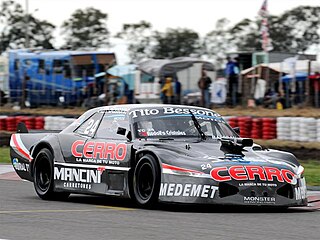
The Dodge Cherokee is a racing car manufactured and developed in Argentina for its participation in the Turismo Carretera. It is a sports development carried out under the regulations of the Asociación Corredores de Turismo Carretera, using the Dodge GTX production model, manufactured in Argentina in the 1970s, as its basis.
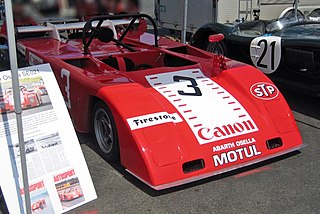
The Abarth-Osella 2000 Sport SE-021 is a mid-engined, Group 5, prototype race car, built by Osella to compete in the World Sportscar Championship sports car racing series in 1972, and for some races in 1973. The chassis itself was developed and developed by Osella, while the car itself was powered by a 2.0 L (120 cu in) Abarth four-cylinder engine, generating a healthy 265 hp (198 kW). Since the light and nimble chassis only weighed 530 kg (1,170 lb), this gave it an incredible power-to-weight ratio.
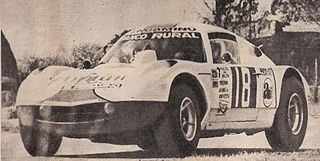
The Liebre Torino, also known as the Hare Torinois a series of race cars that were manufactured between the 1960s and 1970s in Argentina, for use in the Turismo Carretera and Sport Prototipo Argentino categories. These are prototypes created by coachbuilder Heriberto Pronello and motorist Oreste Berta on the basis of the IKA Torino production car.

The Fast Chevrolet, nicknamed the Trueno Naranja, is a racing prototype, designed to run in the Turismo Carretera category, during the 60s. It is a car mounted on a handmade reticulated chassis and powered by a Chevrolet engine from 250 cubic inches and 7 benches. Although the reticulation that forms its chassis was designed by Pedro Campos, which was based on a Lotus Seven, it is recorded in the automotive records with the Chevrolet brand. It had been originally created by the Baufer bodybuilder as the Baufer Ford F-100 Prototype and its preparer was Horacio Steven. your pilot Carlos Pairetti was the one who obtained the 1968 Road Tourism championship with this machine. His name is a connotation of the fastback type design that the car has, while the nickname Thunder Orange, alluded to the color and the speed with which the car performed. From the 1968 championship, two Fast-Chevrolet units took part, the first being the car driven by Pairetti, while the second unit was a gold-painted Fast Chevrolet, which was driven by Oscar Espinosa Fangio. This second car was known by the pseudonym Trueno Dorado.
The Chevrolet prototypes were a series of vehicles that competed in Argentine motorsports presented by different preparers, who powered their machines with Chevrolet engines. The first of them was the revolutionary Chevitú, the creation of José Froilán González and which marked a turning point in Argentine motorsports. The most successful of them was the Trueno Naranja, created by Horacio Steven and champion in 1968, with Carlos Alberto Pairetti at the wheel.

The Baufer-Ford or Steven-Ford was a racing prototype designed and manufactured in Argentina by the defunct Baufer bodybuilder, and serviced by the preparer Horacio Steven to compete in Turismo Carretera. This prototype was created at the request of the official Ford Motor Argentina team, to face the IKA-Renault Torino, which the successful preparer Oreste Berta had presented in 1966, making the official IKA team debut. Ford's objective was to fight and hunt these cars prepared in Alta Gracia, in order to recover the leadership lost in 1966. With the regulatory change of 1967, which allowed the creation of racing prototypes at the pleasure and convenience of the preparers, the prototype devised had V8 engines from Ford F-100 trucks and was mounted on the chassis of a Ford T. This car was indistinctly known as Baufer-Ford for its creator body, or as Steven-Ford, for its preparer.
References
- 1 2 3 "sport prototipo argentino". sportprototipoargentino.blogspot.com (in Spanish). Retrieved 2023-03-10.
- ↑ "Berta LR: El sport prototipo argentino que asombró al mundo". AUTOMUNDO (in Spanish). 2020-10-26. Retrieved 2023-03-10.
- 1 2 Targasport (2022-06-22). "LA POTENCIA DE LOS MOTORES DE SPORT PROTOTIPOS Y MAF1 (PARTE I - 1969)". Targasport (in Spanish). Retrieved 2023-03-10.




